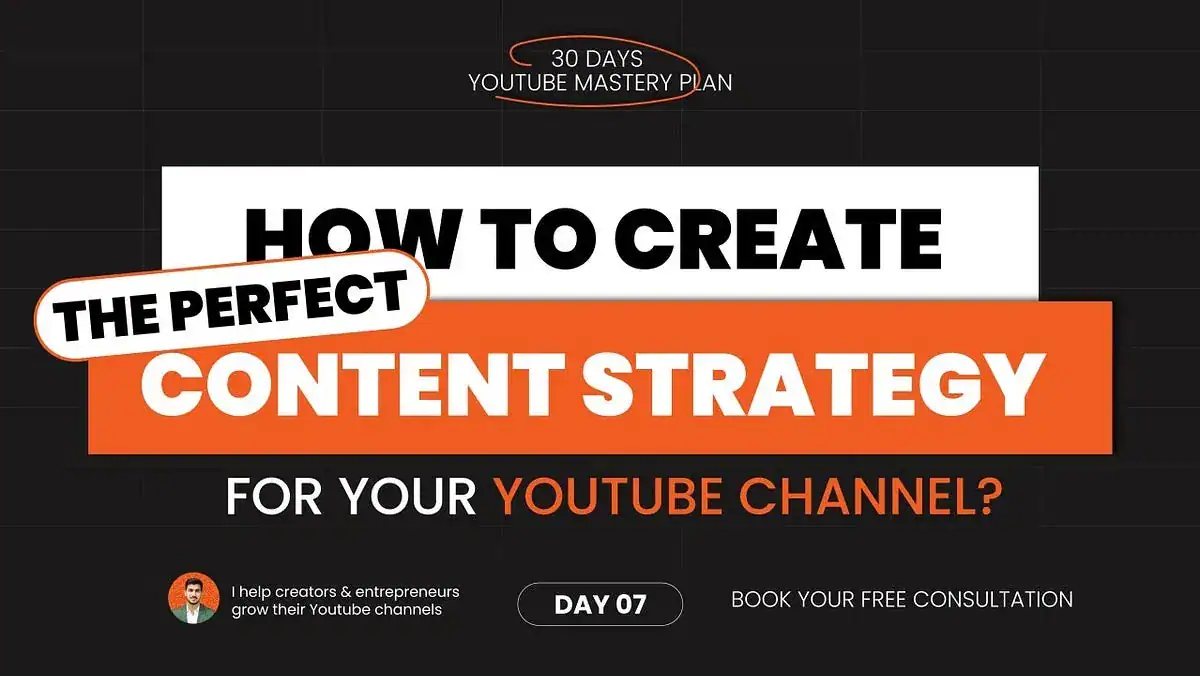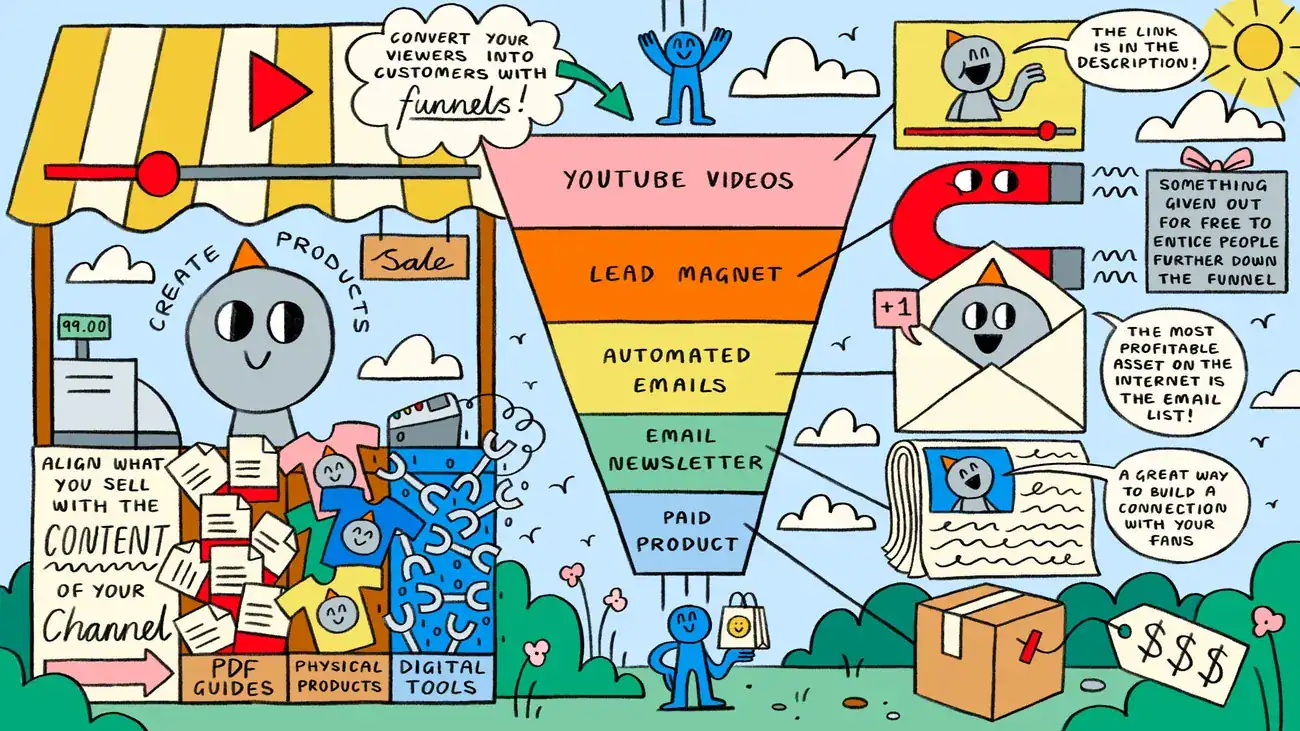YouTube now has more than 114 million active channels competing for viewer attention. That’s a staggering number! Top creators like MrBeast earn up to $54 million annually by posting videos online.
Success on YouTube takes time and dedication. The YouTube Partner Program requires 1,000 subscribers and either 4,000 watch hours in the last 12 months or 10 million valid public Short views within 90 days. These requirements might seem challenging, but an average YouTuber earns around $4,600 per month. The earnings vary based on niche, audience engagement, and monetization strategies. [-5]
Our detailed guide will help you become a YouTube content creator who stands out from the crowd. This blueprint covers everything you need to know about creating a successful YouTube channel and becoming a famous YouTuber.
We’ll show you how to select your perfect niche, set up your channel professionally, create content that appeals to viewers, and grow and monetize your presence. More than 30,000 small businesses trust the platform. YouTube offers more than just fame – it’s a powerful channel to generate additional revenue and brand awareness.
Ready to turn your YouTube dreams into reality? Let’s begin!
Step 1: Choose Your Niche and Define Your Audience

Image Source: Medium
Your YouTube niche sets the foundation of your content experience. A clear focus helps viewers and YouTube’s algorithm understand your channel’s purpose. Let’s explore why this first step is vital for anyone who wants to become a successful YouTuber.
Why niche matters on YouTube
The YouTube algorithm looks at your channel’s genre and shows your videos to people who share similar interests. Channels without focus receive fewer recommendations than creators who have clearly defined their content. On top of that, it helps attract loyal audiences who genuinely care about your specific content. This leads to higher engagement rates that are vital for ad revenue, membership purchases, and sponsorship opportunities.
Note that “Gaming” isn’t a niche—it’s a category. You need to find a content vacuum you can fill with unique videos that viewers love. To name just one example, El Jefe Reviews grew by narrowing down three levels: from tech to personal audio to specifically wireless earbuds and headphones.
How to research your target audience
YouTube Analytics gives you simple demographics like:
- Age and gender
- Geographic location
- When they’re active on YouTube
- Preferred subtitle/closed caption languages
A detailed audience persona helps you understand your viewers’ needs and priorities. This fictional character shows who your most engaged fans are and explains why they take specific actions on your channel.
Looking at what videos they watch outside your channel provides context about their YouTube habits. You should also track new versus returning viewers to measure audience loyalty.
Examples of profitable YouTube niches
These niches are a great way to get substantial income through various revenue streams:
- Technology and Gadgets – Perfect for affiliate marketing and high-value tech sponsorships
- Personal Finance – Features high CPM rates (USD 14.00-21.00) and opportunities for financial tool affiliations
- Health and Fitness – Ideal for building membership communities and workout gear partnerships
- Educational Content – Earns an average RPM of USD 9.89 and attracts dedicated viewers
- Travel and Lifestyle – Appeals to viewers seeking inspiration, with potential for travel gear affiliates
Pick a niche that balances your passion with what viewers want while thinking over monetization potential. Your chosen topic should be something you could talk about for hours—viewers can spot fake enthusiasm from miles away.
Step 2: Set Up and Brand Your Channel
After picking your niche, setting up an eye-catching YouTube channel becomes your next big step. Your channel’s visual identity makes that critical first impression on potential subscribers, so you need to get it right.
Creating your YouTube account
Starting a YouTube channel needs a Google account. You should create a Brand Account instead of using your personal Google account. This lets multiple people manage your channel as you grow. The process is simple – head to YouTube.com, click “Sign in,” then “Create Account,” and pick between personal or business options. Once your account exists, you can start uploading videos, comment on content, and build playlists.
Choosing a channel name and handle
Your channel name and handle (@username) work together to help viewers find you. The channel name shows up on videos and search results, while your handle (with @) helps with mentions and gives direct access to your channel URL. Good channel names should be:
- Short and memorable (under 30 characters)
- Relevant to your content niche
- Unique enough to stand out
- Easy to pronounce and spell
You’ll need to decide between using your real name or creating a brand name that reflects your content. Plus, check if the name is available on other social platforms to keep your branding consistent.
Designing your channel art and logo
A channel banner (2560 x 1440 pixels) and profile image (800 x 800 pixels) create your visual brand. Your banner should tell viewers what to expect, and your profile picture works best with either your face or logo based on your brand strategy. Tools like Canva or Adobe Express help you create professional channel art even without design skills.
Writing a compelling channel description
Your channel description tells both viewers and YouTube’s algorithm what you create. The first 100-150 characters matter most since they appear in search results. Add relevant keywords naturally throughout your description, but don’t overdo it. Focus on explaining what value you bring and when you post new content. Adding your social media links and contact details helps expand your presence on other platforms.
Step 3: Plan and Create High-Quality Content

Image Source: Thumb Scout
Quality content creation forms the backbone of YouTube success. Your 10-year old channel needs to focus on developing videos that engage your audience once you’ve found your niche and set everything up.
Building a content calendar
A YouTube content calendar works as your roadmap and outlines video ideas, filming schedules, and upload dates. A consistent posting schedule builds anticipation among viewers and improves channel visibility without doubt.
Your calendar should work well if you:
- Choose your content frequency based on available resources
- Add key dates and seasonal events to stay relevant
- Structure your calendar with three content types: help content (evergreen tutorials), hub content (regular themed videos), and hero content (major tent-pole events)
Types of videos to start with
Your video formats should match your niche and audience’s interests. According to YouTube Creators Academy, popular categories has entertainment, gaming, beauty, and technology. New creators can start with:
- Educational videos/tutorials (high retention rates)
- Product reviews (most-watched type on YouTube)
- Behind-the-scenes content (creates connection)
- Q&A videos (addresses audience questions directly)
Basic equipment and editing tools
You don’t need expensive gear to start. Your essential gear should include:
- Camera (smartphone with good camera works well for beginners)
- Microphone (significant for clear audio quality)
- Tripod (for stable, professional-looking shots)
- Basic lighting setup
Free tools like YouTube Create give you filters, effects, transitions, and royalty-free music for editing. Canva’s video editor has templates and easy-to-use features that help create thumbnails and graphics.
Tips for scripting and storytelling
Your storytelling approach matters as much as your equipment. Grab attention with a compelling hook in the first 10 seconds. The three-act formula (setup, confrontation, resolution) helps keep viewers involved throughout your video.
Reading your script aloud before recording makes it sound natural and conversational. Small unanswered questions throughout your video create curiosity loops that maintain viewer interest until the end.
Step 4: Grow, Optimize, and Monetize

Image Source: Zach Highley
Your channel needs a boost to start making money now that it’s been around for a while. Smart optimization and monetization strategies will help you build a successful YouTube presence.
Using SEO to get found
YouTube works just like Google – it’s a search engine at heart. You should add relevant keywords to your titles, descriptions, and tags while creating videos. Your main keyword belongs in the first 150 characters of your description to help people find you. Tools like TubeBuddy or SEMRush can help you find keywords that have good search volume but face less competition.
Creating clickable thumbnails and titles
The right thumbnail makes a huge difference – 90% of videos that perform well use custom ones. Your thumbnails should pop with high contrast, match your brand, and use minimal text that people can read on their phones. The titles need to reflect your content accurately. Keywords work best at the start. ALL CAPS and emoji should highlight emotions or special elements only.
Involving your community
Real connections turn casual viewers into loyal subscribers. The numbers show this matters – over 50% of Americans comment online, and 77% use social media platforms actively. The Community tab lets you start discussions, run polls, and connect with subscribers. This space brings everyone together around common interests.
Monetization options: ads, sponsors, affiliates, merch
The YouTube Partner Program requires 1,000 subscribers and 4,000 watch hours in the last year before you can earn from ads. Other money-making options include:
- Affiliate marketing where you earn commission from product promotions
- Brand sponsorships through direct company partnerships
- Merchandise sales that work well with bigger audiences
- Channel memberships offering premium content to paying subscribers
Learning from YouTube Analytics
YouTube Analytics gives a great explanation about your audience and how your content performs. Watch time, CTR (click-through rate), and audience retention are vital metrics to check regularly. The Reach tab reveals how people find your videos, while the Engagement tab shows viewing duration. These insights help you improve your content strategy and grow your channel effectively.
Conclusion
You need strategic planning, consistent effort, and authentic content to become a successful YouTuber in 2025. This piece explores four simple steps that can help turn your YouTube dreams into reality.
Your foundation for success starts with picking the right niche. A clear focus helps viewers and YouTube’s algorithm understand your content better. This leads to improved recommendations and followers who truly care about your videos.
On top of that, a professional channel setup makes a strong first impression. Your channel’s name, handle, artwork, and description create your brand identity. These elements attract potential subscribers before they even watch your content.
Quality content sits at the heart of YouTube success. A content calendar, simple equipment, and good storytelling techniques will help you stand out from millions of other creators.
Growth strategies are equally important. SEO optimization, clickable thumbnails, community interaction, and different ways to monetize will help build a channel that makes money while connecting with viewers.
Note that YouTube success takes time. Getting 1,000 subscribers and 4,000 watch hours might look tough initially. But with commitment and the right approach, you can join thousands of creators who earn around $4,600 monthly.
The time to start your YouTube experience is now. Choose your niche, build your channel, make compelling videos, and use growth strategies effectively. You have the blueprint – now share your unique voice with the world!
Key Takeaways
Here are the essential insights for building a successful YouTube channel in 2025:
• Choose a specific niche over broad categories – Focus three levels deep (like “wireless earbuds” instead of just “tech”) to help YouTube’s algorithm recommend your content effectively.
• Consistency beats perfection in content creation – Build a content calendar with regular uploads using basic equipment; smartphone cameras and free editing tools are sufficient to start.
• Optimize for discovery with strategic SEO – Place primary keywords in the first 150 characters of descriptions and create custom thumbnails (used by 90% of top performers).
• Monetization requires meeting YouTube’s thresholds – You need 1,000 subscribers and 4,000 watch hours annually for ad revenue, but diversify with affiliates, sponsorships, and merchandise.
• Community engagement drives sustainable growth – Respond to comments, use polls, and leverage YouTube’s Community tab to transform casual viewers into dedicated subscribers.
Success on YouTube isn’t just about viral moments—it’s about building authentic connections with your audience while consistently delivering value in your chosen niche. The average YouTuber earns $4,600 monthly, proving that with the right strategy and persistence, YouTube can become a viable income source.
FAQs
Q1. Is starting a YouTube channel still worthwhile in 2025?
Yes, starting a YouTube channel in 2025 can be worthwhile if you approach it strategically. Focus on finding a specific niche, creating consistent high-quality content, and building genuine connections with your audience. While the platform is competitive, there’s still potential for growth and monetization for dedicated creators.
Q2. What are the key strategies for YouTube success in 2025?
Success on YouTube in 2025 involves several key strategies: choosing a specific niche, creating high-quality and engaging content regularly, optimizing for search with effective titles and descriptions, engaging actively with your audience, and staying adaptable to platform changes and trends.
Q3. How can I monetize my YouTube channel in 2025?
There are multiple ways to monetize your YouTube channel in 2025. Once you meet the YouTube Partner Program requirements (1,000 subscribers and 4,000 watch hours), you can earn from ads. Other monetization options include affiliate marketing, brand sponsorships, merchandise sales, and channel memberships for premium content.
Q4. What type of content performs best on YouTube in 2025?
Popular content types on YouTube in 2025 include video tutorials, educational content, product reviews, behind-the-scenes videos, and challenge videos. The key is to create content that provides value to your audience, whether through entertainment, education, or problem-solving, while staying true to your niche.
Q5. How important is audience engagement for YouTube success?
Audience engagement is crucial for YouTube success. Responding to comments, creating polls, and using YouTube’s Community tab can help transform casual viewers into dedicated subscribers. Building a community around your channel not only increases viewer loyalty but also improves your channel’s performance in YouTube’s algorithm.

